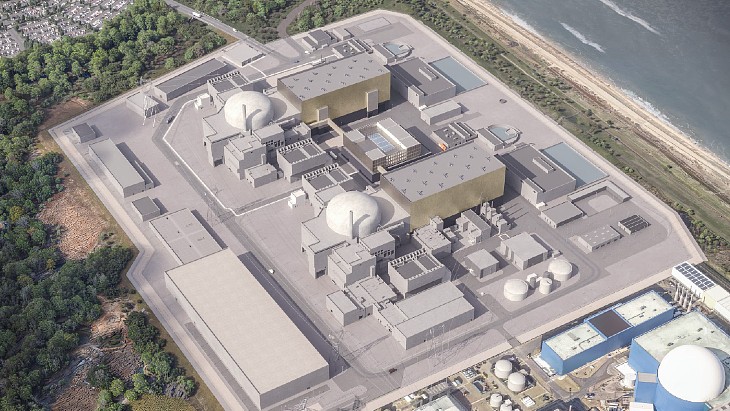A new report by Ontario's Financial Accountability Office (FAO) has confirmed the province's plan to refurbish ten nuclear reactors at Bruce and Darlington, and extend the life of six reactors at Pickering will provide the a long-term supply of relatively low-cost, low emissions electricity over the period to 2064.
.jpg) |
| The Bruce power plant (Image: Bruce Power) |
An Assessment of the Financial Risks of the Nuclear Refurbishment Plan looks at how financial risk would be allocated among ratepayers, the province, Ontario Power Generation (OPG) and Bruce Power. The FAO estimates the plan will result in nuclear generation supplying a "significant proportion" of Ontario's electricity demand from 2016 to 2064 at an average price of CAD80.7 ($63.3) per MWh, in 2017 Canadian dollars.
The effect of the plan on electricity prices will vary over its duration, with prices projected to increase in the short term as the reactors are being refurbished. Prices are expected to peak in 2027, gradually decreasing after that as the refurbished reactors return to service. The CAD80.7 per MWh estimated average cost of nuclear over the period to 2064 is lower than the electricity price of CAD114.9 per MWh currently paid by most of the province's residential and small business ratepayers, the FAO said.
The FAO reviewed the financial risks to the refurbishment plan arising from cost overruns, higher-than-anticipated station operating costs, lower-than-expected electricity demand, and the potential for a lower-cost, low-emissions alternative generation option to emerge.
Ratepayers bear the risk of increases in refurbishment costs for the Bruce reactors until 12 months before each reactor refurbishment begins, at which time the risk is transferred to Bruce Power. They bear the risk of all cost increases "prudently incurred" by OPG, which is owned by the province (the province itself bears the risk of any cost increases not prudently incurred), but benefit from any cost savings. The risks of cost overruns are mitigated by options to terminate refurbishments (known as 'off-ramps'), but these have limited value to ratepayers due to economies of scale at nuclear generating stations and the current cost of low-emissions alternative generation options, the FAO concluded.
Most of the risk that the cost of operating the Bruce reactors will be higher than planned is transferred to Bruce Power through its contract with Ontario's Independent Electricity System Operator, with ratepayers receiving about 50% of the benefit if costs are lower than planned. Ratepayers and the province - through OPG - bear the risk but will receive all the benefit of increasing or decreasing costs of operating Pickering and Darlington. The primary method of protection to ratepayers from increases in OPG operating costs is Ontario Energy Board (OEB) oversight.
The final financial risks analysed by the FAO are lower-than-expected electricity demand, and the potential for a lower-cost, low-emissions alternative generation option, both of which refer to the emergence of unfavourable market conditions.
"The Nuclear Refurbishment Plan requires a CAD25 billion capital investment and price projections are based on costs being spread over a large amount of electricity generation over a long period of time. As a result, reducing nuclear generation or shutting down nuclear reactors in response to unfavourable market conditions is not always economical," the FAO notes.
Insufficient demand for electricity could see the province forced to curtail nuclear generation, export electricity at low or negative prices, or permanently shut down one or more reactors, the report finds. The financial risks of such developments would be borne by ratepayers and, in the case of OPG, the province. Demand-side and supply-side mitigations that could limit demand risk, include increased electrification through Ontario's Climate Change Action Plan, actions to smooth out demand fluctuations, the planned shutdown of the Pickering nuclear power plant by 2024 and the staged shutdown of the Bruce and Darlington reactors beginning in 2043.
The risk that Ontario's commitment to nuclear refurbishment could preclude it from taking advantage of alternative, lower cost, low-emissions grid-scale electricity generation options - should they emerge - would likewise be borne by ratepayers and the province.
"There are currently no alternative generation portfolios that could provide the same supply of low-emissions baseload electricity generation at a comparable price to the Nuclear Refurbishment Plan," the report finds.
Should such alternative options emerge over the life of the plan, economic off-ramps in the Bruce contract and the province's ability to terminate refurbishments at Darlington would go some way to mitigating the risks, it adds.
Bruce Power and OPG have welcomed the FAO's report, agreeing there are currently no alternative generation portfolios that could replace nuclear generation in terms of costs and emissions.
"The FAO's report validates that refurbishing Ontario’s Bruce and Darlington nuclear stations is the best generating option to keep costs low for electricity customers and to protect the environment," the companies said in a joint statement.
OPG began the CAD12.8 billion refurbishment of its four-unit Darlington station in October 2016. One year into the refurbishment project, which will enable the reactors to operate to 2055, work on Darlington unit 2 is almost 40% complete and overall the project remains on time and on budget, the company said. Pickering will continue to operate until 2024 to provide baseload electricity during the refurbishment of the Darlington plants and the first units at Bruce.
Bruce Power's Life Extension Programme began in January 2016 and will see the investment of CAD$13 billion into six of Bruce Power’s eight reactors, allowing the site to operate to 2064.
The FAO provides independent analysis on the state of the province's finances, trends in the provincial economy and related matters important to the Legislative Assembly of Ontario.
Researched and written
by World Nuclear News




_55530.jpg)
_42372.jpg)
_37521_70699.jpg)

_76087_55556.jpg)




